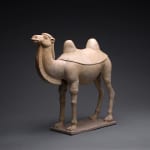Sculpture of a Camel, 581 CE - 618 CE
Glazed Terracotta
height 33.7 cm
height 13 1/4 in
height 13 1/4 in
H.723
Further images
Th camel is an unusual domestic animal; it carries a saddle of flesh on its back; swiftly it dashes over the shifting sands; it manifests its merit in dangerous places;...
Th camel is an unusual domestic animal; it carries a saddle of flesh on its back;
swiftly it dashes over the shifting sands; it manifests its merit in dangerous places; it has a secret understanding of springs and sources, subtle indeed i its knowledge.
--Gu Pu, 3 Century AD
Camels symbolized commerce and its associated wealth,
largely concentrated on profits through trading on the Silk Road. Trade across this extensive network of trails brought prosperity, foreign merchants, and exotic merchandize into the heart of China. However, the dusty trails of the Silk Road were an arduous journey through the rugged mountains and harsh desert of Central Asia that could only b traversed by the two humped Bactrian camel. The government kept vast herds of these invaluable creatures, preside over by civil officials, for hauling their precious commodities across the Silk Road. Camels were a common sight i the cosmopolitan cities of China, carrying both traders and their goods directly into the markets. Likewise, artist began to create charming representations of these prized creatures as
in order to symbolize wealth and prosperity in the afterlife. were works of art created in an ancient Chinese custom specifically for interment in the tombs of elite individuals in order to provide for their needs in the afterlife. Some of the most beautiful works of Chinese art were excavated from such tombs, an this crème-glazed sculpture of a camel is a perfect example of the refine artistry dedicated to such works, despite the facts that they were not intended to be viewed by the living. Most remarkable, this work still retains some of its original painted pigment,
including red highlights on his ears and mouth, which heighten the naturalism. This majestic sculpture reveals China’s respect and admiration for the beast of burden, so essential to their prosperity.
swiftly it dashes over the shifting sands; it manifests its merit in dangerous places; it has a secret understanding of springs and sources, subtle indeed i its knowledge.
--Gu Pu, 3 Century AD
Camels symbolized commerce and its associated wealth,
largely concentrated on profits through trading on the Silk Road. Trade across this extensive network of trails brought prosperity, foreign merchants, and exotic merchandize into the heart of China. However, the dusty trails of the Silk Road were an arduous journey through the rugged mountains and harsh desert of Central Asia that could only b traversed by the two humped Bactrian camel. The government kept vast herds of these invaluable creatures, preside over by civil officials, for hauling their precious commodities across the Silk Road. Camels were a common sight i the cosmopolitan cities of China, carrying both traders and their goods directly into the markets. Likewise, artist began to create charming representations of these prized creatures as
in order to symbolize wealth and prosperity in the afterlife. were works of art created in an ancient Chinese custom specifically for interment in the tombs of elite individuals in order to provide for their needs in the afterlife. Some of the most beautiful works of Chinese art were excavated from such tombs, an this crème-glazed sculpture of a camel is a perfect example of the refine artistry dedicated to such works, despite the facts that they were not intended to be viewed by the living. Most remarkable, this work still retains some of its original painted pigment,
including red highlights on his ears and mouth, which heighten the naturalism. This majestic sculpture reveals China’s respect and admiration for the beast of burden, so essential to their prosperity.







